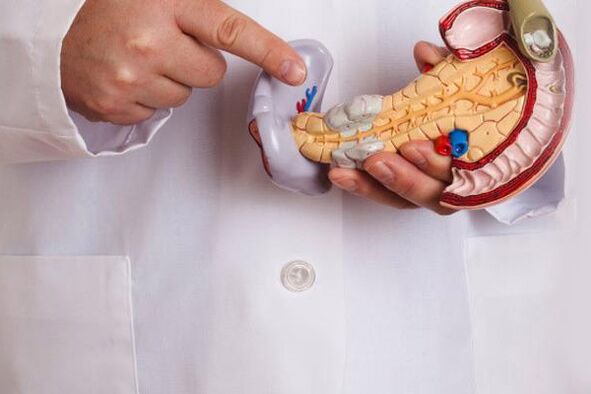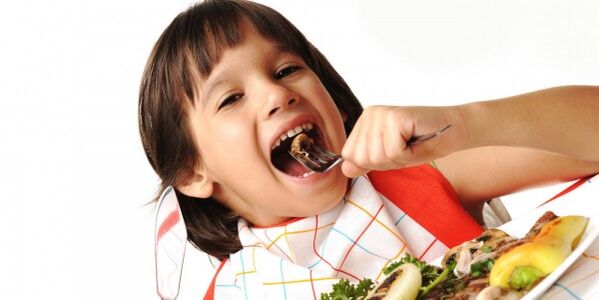Pancreatitis diet is the main factor in successful treatment, therefore, adhere to dietary restrictions can lead a fulfilling life and reduce the possibility of recurrence.
Pancreatitis is inflammation of the pancreatic tissue, accompanied by impaired secretion of digestive enzymes, severe pain, stool changes, and vomiting. This can lead to pathological metabolic disorders and may lead to the development of diabetes. The main factors of pancreatitis are: overeating, abuse of high-fat foods and alcohol.
It is necessary to follow the pancreatitis diet for a long time. Acute inflammation requires dietary restriction for 6-9 months, while in chronic pancreatitis, diet must be adhered to for several years or life.
Power characteristics

The method of prescribing a diet for pancreatitis depends on whether the inflammation is an acute or chronic form. The doctor noticed the positive effect of diet on pancreatitis. It allows you to quickly overcome acute inflammation, avoid complications, and prolong the remission period in chronic processes.
Diet characteristics:
- You must refuse food completely within 2-3 days after the acute onset of pancreatitis. Therefore, provide rest for the pancreas. Therapeutic fasting includes the use of non-carbonated alkaline mineral water, weakly brewed tea, or rosehip infusion, 5-6 times a day, one cup each time.
- On the fourth day after the start of therapeutic fasting, solid foods were gradually introduced into the diet. Usually, these are low-calorie foods without salt, which will gradually increase the secretion of gastric juice.
- For pancreatitis, the way you prepare food is important. Steam cooking is recommended, because food prepared in this way retains all the necessary substances and does not harm the digestive tract.
- Food should not be too cold or too hot, and the best temperature is close to body temperature. In this case, the food should be ground or semi-liquid.
- Pancreatitis diet may even restrict diet. They eat small portions at least five times during the day.
The diet does not include the following foods:

- Fat;
- Deep frying;
- Hot sauce and spices;
- Sour juice
- Canned food, kimchi;
- bacon;
- candy;
- Cocoa, chocolate
- alcohol.
The energy value of this food should be at the level of 2500 kcal.
The disadvantage of this diet is a severe shortage of plant-based foods. Some ingredients need to be compensated by taking multivitamins and food supplements.
Acute pancreatitis diet
Diet treatment of pancreatitis is an integral part of treatment. During the exacerbation, the attack is accompanied by severe stomach pain and loss of appetite, so the first few days of medical fasting will not cause pain to the patient.
In addition, low-calorie foods are gradually introduced into the diet. It can be uncooked dry bread, berry juice and jelly, viscous soup of oatmeal and rice, and oil-free liquid mashed potatoes. At this time, it is recommended to exclude products that contribute to gas formation.
On days 6-7, gradually introduce protein dishes: steamed meat, mashed potatoes or vegetable pudding, steamed protein omelet.
It should be noted that the diet requires long-term compliance with dietary restrictions. For 6-9 months, you need to strictly abide by its rules and monitor your diet every day.
The course of the disease may have certain characteristics, so gastroenterologists and nutritionists engage in dietary appointments. Taking into account the comorbidities, the experts in this data have determined what can be eaten in the pancreatitis diet for each specific patient.
After the acute phase of the disease subsides, you can significantly diversify your menu with simple and healthy products. It should be noted that the number of meals should be at least four meals, and the amount of liquid consumed per day is about 1. 5 liters.
Example menu:
- Breakfast: Semolina (rice) water-cooked porridge; apples; green tea brewed with a spoonful of honey.
- The second breakfast: steamed chicken breast; carrot puree; rose hip decoction.
- Lunch: vegetable soup with beef or fish; mashed potatoes; white bread croutons; baked apples without skin.
- Afternoon snack: low-fat cottage cheese; green tea with a spoonful of honey.
- Dinner >: Steamed egg rolls from three eggs; mashed potatoes from dietary vegetables; white bread croutons.
- Before going to bed: curd.
Through dieting, the symptoms and treatment of pancreatitis have been significantly alleviated. This nutrition protects the pancreas from damage and gradually normalizes its work. The patient's health will depend on how strict his diet is. Any disorder in the diet will be immediately reflected in the digestive function.
Diet for chronic pancreatitis
Chronic pancreatitis most often occurs in the context of an acute disease, but if it is a complication of other diseases, it can also occur as a primary disease.
The diet and treatment of pancreatitis are two inseparable concepts. Even during remission, dietary guidelines should be followed.
Dietary rules for chronic pancreatitis:
- During this period, the calorie content of food should be commensurate with daily physical activity.
- People are very concerned about the protein content in food. Turkey, chicken, rabbit, beef, lean pork and fish are allowed.
- Lamb, fatty pork, goose, duck and game dishes are not allowed in the diet.
- Heat-treated foods are not allowed to be fried, baked in the oven, or stewed. Food must be cooked or boiled in a double pot.
- Cheese, which was previously banned during the aggravation phase, is now allowed to be used in small amounts, but it is recommended to use fermented dairy products instead of milk.
- The diet should include plant protein, represented by cereals and yesterday’s bread, and it is necessary to consider that beans should be completely excluded from the diet with pancreatitis.
- The total amount of carbohydrates should not exceed 350 grams per day. They are found in pasta, cereals, honey, preserves and syrups.
General diet menu for chronic pancreatitis:
- Breakfast: boiled rabbit meat; rice porridge.
- Late breakfast: low-fat cottage cheese; baked apples without honey.
- Lunch: buckwheat soup; boiled or steamed fish with vegetables; dried fruit compote.
- Afternoon snack: steamed meatloaf with vegetable sauce.
- Dinner: veal, unsweetened curd pudding; weak tea.
- Before going to bed: Kefir.
The meals are scattered and small. Food should be heated every about three hours.
Salt and spices will increase the secretion of enzymes in the digestive tract, so their amount should be kept to a minimum. In addition, sour flavors, smoked foods, baked goods and sour cream and chocolate have similar effects. Sugary foods can cause complications such as diabetes, so its content in the diet is reduced by 90%.















































































